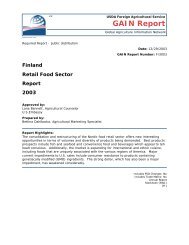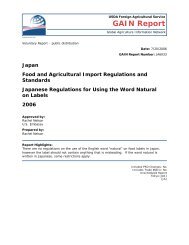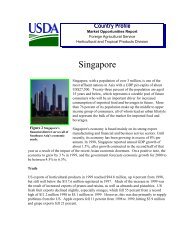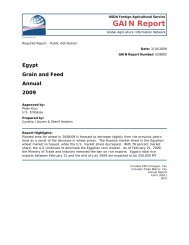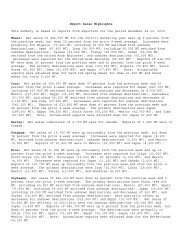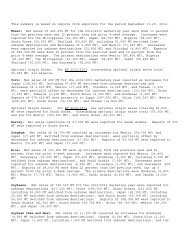statement by bud philbrook deputy under - Foreign Agricultural ...
statement by bud philbrook deputy under - Foreign Agricultural ...
statement by bud philbrook deputy under - Foreign Agricultural ...
Create successful ePaper yourself
Turn your PDF publications into a flip-book with our unique Google optimized e-Paper software.
STATEMENT BY BUD PHILBROOK<br />
DEPUTY UNDER SECRETARY FOR FARM AND FOREIGN<br />
AGRICULTURAL SERVICES<br />
U.S. DEPARTMENT OF AGRICULTURE<br />
BEFORE THE HOUSE COMMITTEE ON FOREIGN AFFAIRS<br />
SUBCOMMITTEE ON AFRICA AND GLOBAL HEALTH<br />
WASHINGTON, DC<br />
THURSDAY, JUNE 4, 2009<br />
Mr. Chairman, members of the committee, I am pleased to appear<br />
before you today to discuss the role of local and regional purchase of U.S.<br />
food aid in the context of the U.S. Department of Agriculture’s food aid<br />
programs.<br />
Background<br />
The Food, Conservation, and Energy Act of 2008 (the 2008 Farm Bill)<br />
directed USDA to <strong>under</strong>take a local and regional procurement pilot program.<br />
USDA is pleased to bring its expertise in food aid delivery to implement this<br />
program effectively.<br />
USDA’s food aid programs have helped feed millions of hungry people<br />
around the world. We are proud to operate both the Food for Progress<br />
Program and the McGovern-Dole International Food for Education and Child<br />
Nutrition Program.<br />
1
Local and regional purchase of food aid has the potential to provide<br />
another tool – like prepositioning of food commodities which is also an<br />
important tool but not a substitute for local and regional purchase -- in support<br />
of President Obama’s commitment to work in partnership with the people of<br />
poor nations “to make your farms flourish and let clean waters flow; to<br />
nourish starved bodies and feed hungry minds.”<br />
The pilot program will help inform USDA on how efficient and cost-<br />
effective local and regional purchases compare to traditional food aid<br />
procurement.<br />
Local and Regional Food Aid Procurement Pilot Project<br />
The 2008 Farm Bill directs the Secretary of Agriculture to implement a<br />
local and regional purchase pilot program in developing countries through<br />
fiscal year 2012. Congress specifically directed that the pilot program be<br />
used for food crises and disasters, as well as field-based projects that provide<br />
development assistance for a period of not less than one year. Additionally,<br />
the Secretary is to implement the program in a way to ensure that it will not<br />
disrupt the local and regional markets.<br />
The first step in designing the program was for the Secretary of<br />
Agriculture to submit a study on local and regional procurement to the House<br />
2
of Representatives Committee on Agriculture, the Senate Committee on<br />
Agriculture, Nutrition and Forestry, and the House of Representatives<br />
Committee on <strong>Foreign</strong> Affairs. That report was provided in January 2009.<br />
USDA consulted with the U.S. Agency for International Development,<br />
given its experience with local and regional procurement, as well as with<br />
other donor countries, private voluntary organizations (PVOs), and the World<br />
Food Program of the United Nations in preparing the study. The study found<br />
the following:<br />
• Local and regional purchase is an important tool, enabling food aid<br />
agencies to respond quickly to emergency food needs, both during and<br />
after food crises and disasters.<br />
• Local and regional purchase can be a timely and effective complement<br />
to in-kind food aid programs.<br />
• Market intelligence on when and how to use appropriate local and<br />
regional purchase methods to meet food aid needs, and avoid harming<br />
low-income consumers, producers, and fragile market systems, is<br />
critical.<br />
We will issue guidelines to implement the pilot program <strong>by</strong> mid-July.<br />
After publishing the guidelines, USDA will begin to solicit proposals<br />
from organizations to conduct local purchase pilot programs. These<br />
3
organizations must be eligible <strong>under</strong> the Food for Peace Act and, in the case<br />
of PVOs, subject to the guidelines promulgated for this pilot program. The<br />
Farm Bill provides that the Secretary shall use $25 million of Commodity<br />
Credit Corporation (CCC) funds in each of fiscal years 2010 and 2011 to<br />
implement the local and regional purchase pilot program.<br />
The Farm Bill requires a diversity of field-based projects be <strong>under</strong>taken in<br />
food surplus regions, food deficit regions, and multiple geographical regions.<br />
Africa is designated as the priority area of operations, and USDA is required<br />
to fund the majority of field-based projects in Africa.<br />
Finally, the Farm Bill requires the Secretary to ensure that an independent<br />
third party conducts a comprehensive independent evaluation of the field-<br />
based pilot projects. The independent evaluation must include a number of<br />
factors, including prevailing and historic price movements of the local<br />
markets, the impact on local consumer prices, costs for storage, handling,<br />
transportation, and administration, and the impact on large and small<br />
producers. The Farm Bill provides that the Secretary shall use $5 million of<br />
CCC funds in fiscal year 2012, the year in which the evaluation will be<br />
carried out.<br />
USDA has the capacity to implement the pilot program. Our experience<br />
with the pilot will help inform us for the future.<br />
4
Government Accountability Office Study<br />
It is timely that the Government Accountability Office (GAO) was doing<br />
a study of local and regional procurement at the same time that USDA was<br />
studying this tool. We came to many of the same conclusions as GAO. The<br />
GAO study has highlighted some additional points to consider when<br />
implementing local and regional procurement. USDA has reviewed the GAO<br />
study thoroughly.<br />
We agree with GAO that local and regional procurement is an important<br />
tool that, when used appropriately, at the right time and <strong>under</strong> the right<br />
conditions can reduce commodity and transportation costs and shorten<br />
delivery times. We share GAO’s concern that poorly targeted local and<br />
regional purchases have the potential to lead to price spikes and shortages of<br />
staple foods in source countries. Likewise, poorly targeted distributions of in-<br />
kind food aid have the potential to depress prices and negatively impact<br />
domestic production in recipient countries. USDA agrees that the best way to<br />
mitigate these potential adverse affects is through improved market<br />
intelligence.<br />
As GAO noted, the existing memorandum of <strong>under</strong>standing on cargo<br />
preference does not specifically addresses issues related to local and regional<br />
purchases. While cargo preference is not the subject of this hearing, USDA<br />
5
looks forward to working with the U.S. Agency for International<br />
Development and the Maritime Administration to clarify the application of<br />
cargo preference to this type of food aid.<br />
Creating Sustainable Economic Growth<br />
In addition to feeding hungry people, USDA’s food aid programs<br />
provide opportunities to use USDA’s global capacity building and<br />
development expertise to help developing countries create sustainable<br />
economic growth that improves people’s lives. We can share with developing<br />
countries the tools they need to develop their own extension services; educate<br />
farmers, food processors, shippers, marketers, and exporters in the latest<br />
agricultural technology; build cold storage and food production facilities; and<br />
get agricultural products to market for domestic or foreign consumption.<br />
These tools complement other such activities <strong>under</strong>taken <strong>by</strong> the U.S. Agency<br />
for International Development (USAID), and the Department of State to help<br />
the United States Government (USG) better enable developing countries<br />
attain food security.<br />
We strongly believe that successful developmental efforts come from<br />
the local level. USDA and the <strong>Foreign</strong> Assistance agencies of the USG have<br />
knowledge and resources that can assist with development, but recipients best<br />
6
know their barriers and needed actions. We must work in partnership with<br />
the recipients to design sustainable and effective projects.<br />
Fully Utilizing USDA’s Food Aid and Development Programs<br />
USDA, like all parts of the USG food aid implementers, has built long-<br />
term capacity building and development aspects into all our food assistance<br />
programs. This makes them well-suited to respond to the President’s call to<br />
help stabilize emerging economies and rejuvenate failed and weakened states.<br />
For example, last month Secretary Vilsack announced plans for $27.5<br />
million in assistance for Pakistan and Afghanistan <strong>under</strong> our Food for<br />
Progress Program. The Government of Afghanistan will use the proceeds<br />
from the sale of U.S.-donated vegetable oil to implement agricultural and<br />
rural development projects.<br />
We are particularly proud to administer the McGovern-Dole<br />
International Food for Education and Child Nutrition (McGovern-Dole)<br />
Program. To date, USDA has provided meals to more than 22 million<br />
children and boosted attendance in schools in 41 countries, particularly for<br />
young girls, <strong>under</strong> the McGovern-Dole Program and its predecessor.<br />
McGovern-Dole Program funds have helped build school gardens and fish<br />
ponds; improve sanitation systems; rehabilitate schools; and remove<br />
7
unexploded ordnance preventing children from attending school. The<br />
Administration requests a historic doubling for this program from $100<br />
million in the FY 2009 Omnibus Appropriations Act to almost $200 million<br />
in the President’s FY 2010 Budget, in order to serve additional children.<br />
Conclusion<br />
The Administration is committed to a permanent solution for food<br />
insecurity. We look forward to implementing the local and regional<br />
procurement pilot program and using it as another tool to achieve our goal of<br />
improving the lives of hungry and malnourished people. I look forward to<br />
any comments or questions you may have. Thank you.<br />
#<br />
8



